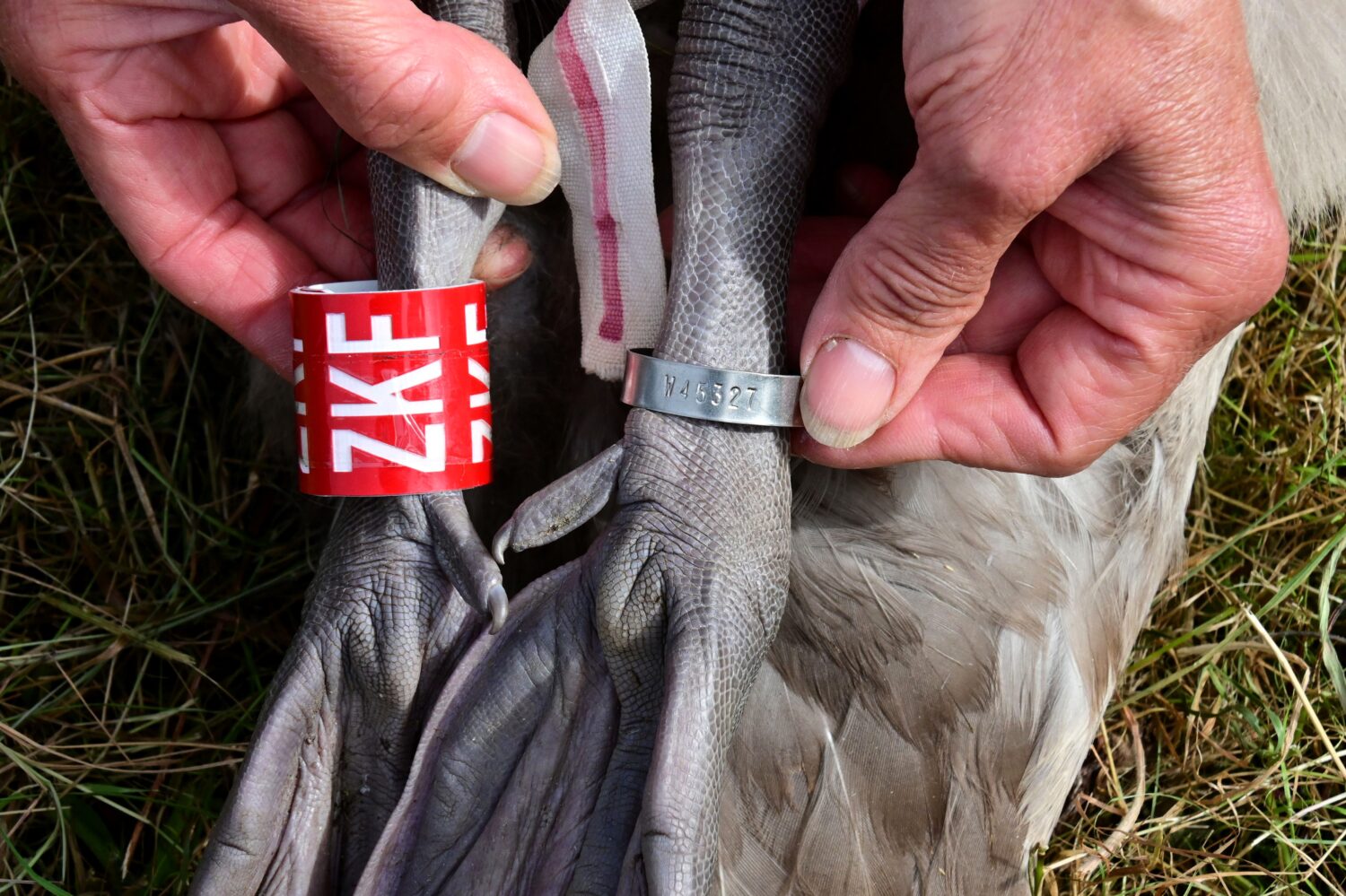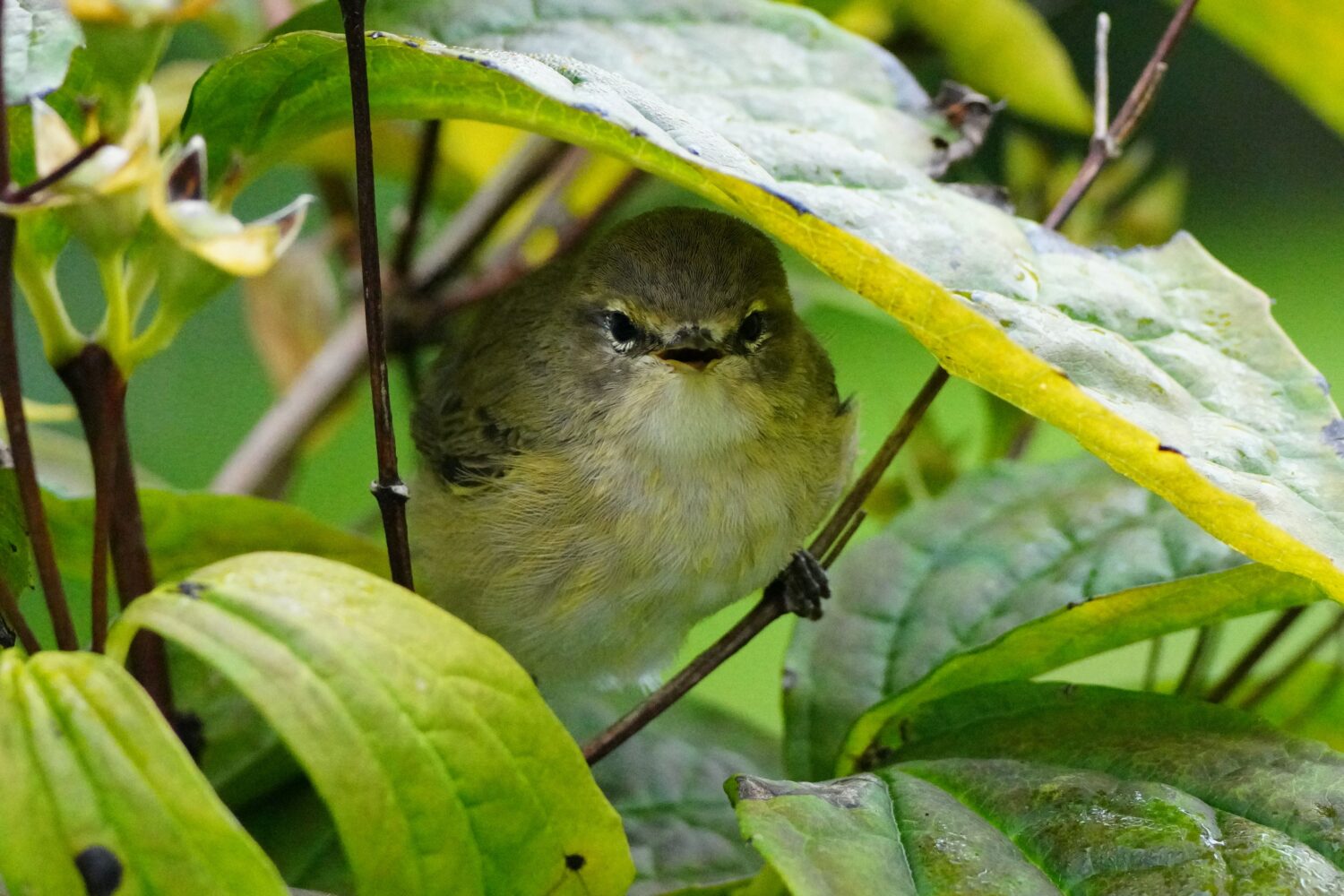In Ringer’s Year September 2023, local ornithologist Phil Hanmer summarises a month of ringing effort.
The aftereffects of Storm Arwen are still apparent to many of us that live in the countryside with partially cleared woodlands on our doorstep and even some that are still a jungle of fallen trees making the woods all but impenetrable. In one wood up the Breamish Valley we had assumed two boxes had been lost entirely. However, regaining access to this site recently revealed a pleasant surprise. Not only had one box survived intact but it had definitely been used by a Goldeneye duck in 2023, with three unhatched eggs being left behind in a box lined with duck feathers and small bits of hatched eggshell. Checking three boxes at this location and revisiting all the other data on the usage of these boxes along the valley means I have to revise my earlier figures. So, there were fourteen nesting attempts by Goldeneye between April – June, the same as in 2022, 11 of which were successful, also the same as 2022. Although arguably an additional nesting attempt took place in a box that was subsequently taken over by a Tawny Owl as two cold duck eggs were found when the box was cleaned out in September! This was the ‘usual situation’ of an owl taking possession of a box that it considered was its property; a situation we had sought to mitigate by erecting two additional boxes near this location at Hedgeley a few years ago. However, due to Storm Arwen damage these boxes were both lost and it’s been impossible to replace them. As already reported a couple of months ago a fascinating reversal of this ‘usual situation’ occurred at another location west of the A697. Here a duck started nesting and laid seven eggs; then an owl attempted a take-over and we even captured and ringed it. Then the duck came back apparently chased the owl away and laid some more eggs and actually evicted one of the owl’s eggs! This female Goldeneye [FH79908] had first nested at this same location in 2022.
Four brand new adults were ringed and eight retrapped. Of the retraps two had been first ringed back in 2017 and so are probably eight yrs. old. Three clutches were not incubated; and at least one having been the victim of egg dumping with 16 cold eggs being found in the box. This is still the only regular colony of Goldeneye Ducks in England & Wales. There were also three successful Tawny Owl nests.
The exciting event of this month, for my trainees, has been their introduction to the sometimes ‘wet’ activity of ringing families of Mute Swans! The resident male swan at Howick is easily recognizable by his colourful darvic or plastic ring ZJP (white letters on a red background). He has been at Howick since 2014 and acquired his present mate in 2021 (now ZKA). She was ringed as a cygnet in 2018 at Herrington Country Park so we know exactly how old she is. This pair first bred in 2022 raising two young. This year they originally had four young but lost one a few months ago. On the 1/9/23 we gathered at Howick and Alison and the Head Gardener (Robert Jamieson) enticed all the swans up onto the bank with the offer of grain and duck pellets. Everyone had been briefed to catch the young birds as a priority; because once these are caught the adults do tend to be so inquisitive that they will come very close to see what is happening that they are more easily captured by the stronger members of the ringing team! So, everyone was shown how to put first a ‘permanent’ metal ring on one leg and then the larger brightly coloured darvic on the other. We took some biometrics and noted particularly that the cygnets weighed: 7.25kg (ZKB); 7.0kg (ZKC); and 6.5kg (ZKF) almost certainly a female. We were able to put a darvic on the female (in addition to the metal she already carried) so she is now much more recognizable as ZKA and found she weighed 9.0kg. Finally capturing Male ZJP he weighed in at a heavy 12.75kg! All the swans were rapidly released and within a few minutes were coming back to accept food.
Some of the same team gathered at South Linden on the 5/9/23. Here a rather laid-back male swan (ZKH) and an unusually dominant (not to say feisty) female (VAH) have taken up residence. They raised two cygnets this year which weighed 6kg (ZKR) probably a male; and 4.5kg (ZKT) female. The most interesting fact here is that we can tell from ringing that female VAH is 19 yrs old, having been originally ringed at Tynemouth in January 2005. This is a great age for a breeding female swan.


Finally, we were invited down to ring more swans at a Nature Reserve in Morpeth. Here we were able to ring 4 cygnets out of 5 (one just got away) at 5.75kg (ZKI); 4.0kg (ZKJ); 2.25kg (ZKL); and at 4.25kg (ZKN). We also caught the female and added a darvic (ZK6) to her metal ring that told us she was ringed in March 2019 at Woodhorn; she weighed 10.25kg. We did not catch the male but we do know from his existing rings that he was ringed in July 2017 at Annitsford Pond.
I have labored the point of the colorful darvic rings because we really would like your help in tracking these swans (Infact any darvic ringed swan). Please if you see a swan with a plastic ring on just make a note of the letters or numbers and their colours and tell me where you saw it.
Still dodging the unsettled weather and getting worse weather forecasts we have continued to ring at Howick Arboretum. On the 1st of September we ringed 75 birds (46 new and 29 retraps). The retraps included a 9 year old female chaffinch that we ringed at the same site in 2014! The highlight of the new birds was a Lesser Whitethroat that was on its first migration south. They migrate south via Northern Italy and then apparently down to winter in Sudan, Chad and Ethiopia. We captured another new Garden Warbler the same day perhaps on its way to Ghana or Nigeria. There were also a number of Chiffchaffs, Blackcaps, and our rather more sedentary local tits. One of the Chiffchaffs stayed around in a low tree for several minutes after being ringed enabling me to take its picture (see photo.) Gathering again on the 2/9/23 for a rather quieter morning we only captured 26 birds (17 new and 9 retraps) but again including several Blackcaps which love to feed on the berries in the Arboretum. On the 8/9/23 we were back up to 60 birds (40 new and 20 retraps) with the new birds including Blackcaps, Chiffchaffs. Notably some of the Blackcaps were carrying a lot of stored fat, indicating their preparations to migrate south to the Mediterranean and North Africa. On the 9th we captured 39 birds (29 new and 10 retraps) including a retrapped Goldcrest, first ringed in 2022 as an adult. This is actually quite unusual because the proportion of young (hatched in the current year) goldcrests in the population is always huge relative to older birds. Included in the new birds were a lot more goldcrest (indicating an influx of migrants from the north and east) Blackcaps, and yet another Garden Warbler.

On the 17th we were up to 75 birds again (55 new and 20 retraps) including yet another nine yr old Chaffinch (Howick chaffs live a long time). The new birds included an influx of Blackbirds (coming to eat berries) and migrating Blackcaps. The 22nd yielded 52 birds (42 new ands 10 retraps) including travelling Blackcaps and Chiffchaffs both moving south. Finally, on the 23rd we caught 50 birds (33 new and 17 retraps). Notably Bullfinches (something of a Howick specialty in the winter) seemed to have moved into the ringing site to hunt the bushes for nice berries. There were also Goldcrests (coming in) and Blackcaps and Chiffchaff (going out). I have added a good photo of a male and female Blackcap, both young birds but showing their proper adult colours. Finally, on the 30th we were able to ring again and captured 53 birds (43 new and 10 retraps). There was still no sign of significant migration from Scandinavia (of Thrushes for example) but there were a lot of Goldcrest, Chiffchaff and Blackcap moving through Howick.
